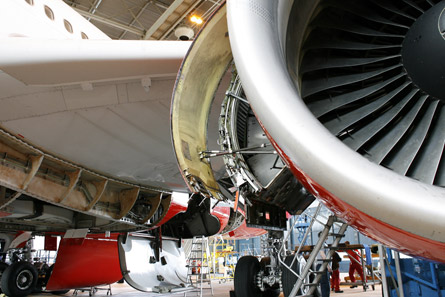It was a gradual but almost complete withdrawal from the maintenance, repair and overhaul (MRO) sector. In February 2011, Finnair axed its airframe heavy maintenance business blaming "inadequate cost-competitiveness" for the labour-intensive work. But the Nordic carrier still saw a chance for its engine and component overhaul shops to support its own fleet and third-party customers.
Some 15 months later, however, Finnair decided to close those facilities and outsource work to Mubadala Aerospace MRO Network member SR Technics in Zurich. In April, Finnair chief operating officer Ville Iho said the component and engine businesses were "too small in scale to be cost-efficient enough in the long term". The carrier inked a 10-year contract with SR Technics, covering not only MRO for its CFM International CFM56 engines and fleet-wide components, but also the sale and lease-back of equipment - including spare engines - through Mubadala's financing arm Sanad. In future, Finnair will only conduct line maintenance in-house.
 |
|---|
| Air Berlin Technik |
Meanwhile, across the Atlantic, Canadian MRO provider Aveos Fleet Performance filed for insolvency in March 2012 after its main customer, Air Canada, withdrew part of its work. Initially there was hope that the Montreal-based maintenance company could continue to operate its engine and component facilities, but the staff never returned to work.
The component overhaul shop only opened in 2011 but Aveos never won sufficient custom beyond its former parent carrier to make its business work. In August, UK spare part specialist A J Walter took over the component shop, while Lufthansa Technik (LHT) is poised to win the engine maintenance deal - although that work will shift to Germany.
SIZE MATTERS
Scale and market weight are increasingly crucial factors for MRO providers as airlines battle low profit margins and come under pressure to reduce costs. Maintenance is an obvious area when eyeing savings and - like Finnair - many opt to outsource their technical requirements. MRO providers, in return, can offer economies of scale. Large work volumes not only bring down the price for airframe, component or engine maintenance, but existing technical and managerial expertise helps to build capabilities for services and new types of equipment. This is particularly important if large investments are needed to extend capabilities to new aircraft.
A further trend, which favours larger MRO providers, is the growing appetite among airlines to simplify the supply chain and work with fewer service providers. Instead of having to manage multiple external partners - such as specialist component repair shops - carriers want to appoint a few partners which offer a full range of services. This may include access to spare part pools and logistics across a wide network, which the operator can later use on a leasing basis.
"For quite a few years the integrators have been playing a growing role [in offering] a one-stop shop," says David Marcontell, president of the TeamSAI consultancy in New York. "While this is not to say that there is no space for specialists, that space is getting smaller."
Individual maintenance companies may be able to score over larger competitors in cost terms, owing to fewer overheads or their geographic location, but low labour rates alone may not be enough to win a deal and sustain a partnership over time. "It is a balance of cost versus performance, such as quality, turn-time and reliability," Marcontell points out. "If an MRO [provider] is unable to find that balance consistently they won't stay in business."
New-generation aircraft such as the Boeing 787 and Airbus A350 are expected to further reduce diversity and choice in the MRO market because of the large investment needed to establish repair capabilities and provision for spare parts. This is exacerbated by the fact new equipment should offer greater reliability which, in turn, means less maintenance.
"MRO providers will not be able to make the economics work on the new platforms unless they have a significant fleet to look after," says James Stewart, group chief executive of the Mubadala Aerospace MRO Network. "So in order to make their investment pay off, they really need to capture a global fleet."
INDUSTRY SPLIT
Stewart foresees a split in the MRO industry, where new aircraft platforms will be supported by a small number of global maintenance providers, which work in strategic partnerships with airlines or OEMs. These MROs will also cater for mid-generation equipment, such as the 777 and A330, but there will be a separate tier of maintenance companies to support older types approaching their sunset period.
 |
|---|
| SR Technics |
A key question is how the component MRO sector will develop. There is still a broad range of individual specialist repair shops - especially in the USA - which cater for current-generation aircraft, such as the 737 or A320. But Jonathan Berger, vice-president at consultancy ICF International in New York, expects a "big, heavy" wave of mergers and acquisitions to go through this fragmented sector in the future, with individual companies becoming part of OEMs or MRO groups. This consolidation will be largely driven by component manufacturers pursuing the same philosophy for new equipment as the engine makers, which have seized the aftermarket and now command the majority of the engine-support business against a limited number of large MRO groups.
The component OEMs are restricting free access to repair manuals and engineering data to control the aftermarket. Even large MRO groups like Air France Industries-KLM Engineering & Maintenance, Lufthansa Technik and Mubadala Aerospace have decided to co-operate with Hamilton Sundstrand to be able to support the 787. But whether the component OEMs' tighter aftermarket control will lead to the same outcome as in the engine MRO sector is unclear.
DIFFERENT BALANCE
LHT chief executive August Wilhelm Henningsen predicts a different balance, as aircraft will be equipped with components from various OEMs while the engines come from only one manufacturer. Even though the number of component OEMs on new aircraft is declining because of consolidation in the supplier industry, operators will still need MRO providers which can support a range of systems.
Henningsen thinks there is growing concern among airlines over monopolistic tendencies in the industry, which he believes could lead to greater interest in choice between alternative service providers. But in the current economic climate, where airlines battle low profit margins, he expects many will make price-led, opportunistic decisions rather than pursue long-term strategic objectives on how they want to position themselves toward their suppliers.
Marcontell also expects OEMs and large MRO groups to continue to compete in the maintenance market because customers appreciate the latter's reverse-engineering capabilities and in-house repairs as an alternative to OEM solutions. However, this will depend on whether the MRO providers have enough resources to develop such services and attract large airline customers which can demand the necessary engineering data from the manufacturers through their fleet orders.
In other words, it will depend on scale - and favour the larger MRO groups.
Source: Flight International























